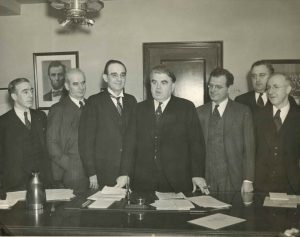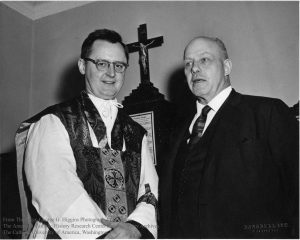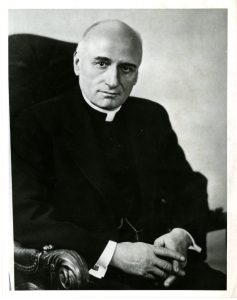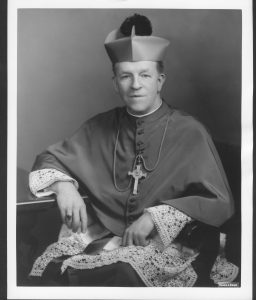A previous blog post recounted CatholicU’s Gilded Age and Progressive Era Labor Collections, part of Special Collections that includes materials from the New Deal and Postwar Era. These include the Congress of Industrial Organizations (CIO), 1935-1955; three high ranking CIO officials, Phillip Murray, John Brophy, and Harry C. Read; and Joseph Daniel Keenan of the International Brotherhood of Electrical Workers. Finally, there are collections connecting the Catholic Church and labor via ‘labor priests’ Msgr. John Augustine Ryan, Bishop Francis Joseph Haas, and Msgr. George Gilmary Higgins. CatholicU has online guides (or finding aids) to the collections, with select scanned content online, while others are being systematically digitized in partnership with ProQuest’s History Vault, as previously done with the Gilded Age and Progressive Era Collections.
Congress of Industrial Organizations (1935-1955)
In 1935, critical of the American Federation of Labor (AFL) refusal to organize industrial workers, disgruntled AFL leaders, including John L. Lewis of the United Mine Workers (UMA), formed the Committee for Industrial Organizations (CIO). Encouraged by worker activism and federal recognition, the CIO evolved into an independent federation confirmed by their 1938 name change to the Congress of Industrial Organizations. The CIO promoted collective bargaining in mass industries such as steel and auto and their commitment to organizing unskilled, semi-skilled, and skilled workers, including African-Americans, demonstrated egalitarian goals. The CIO merged with the AFL in 1955 and CIO records were transferred to CatholicU in several installments between 1962 and 1976.

Philip Murray (1886-1952)
In 1904, Philip Murray, a young Scottish immigrant coal miner in western Pennsylvania, terminated from his job and evicted from his home, thereafter devoted his life to unionism. He became one of the most important labor leaders in twentieth century America as Vice President of the United Mine Workers of America (UMWA), 1920-1942; second President of the aforementioned CIO, 1940-1952; and first President of the United Steel Workers of America (USWA), 1942-1952. He supported civil rights, fought Communism, and smoothed relations with the rival AFL leading to the merger of 1955. His vision of social justice derived from family union tradition and Catholic faith inspired by papal encyclicals. A member of the NAACP, Murray was also a naturalized American citizen who spoke with a Scottish accent. His papers at CatholicU are described in an earlier blog post.
John Brophy (1883-1963)
The Lancashire born John Brophy began working in the coal mines of Pennsylvania in 1894. As a union activist, Brophy was elected president in 1916 of UMWA District 2, representing Central Pennsylvania and advocating for health care until 1926 when he unsuccessfully challenged John L. Lewis for the UMWA presidency. Brophy later worked for the fledgling CIO, often traveling abroad to meet with international labor organizations. His autobiography, edited and rewritten with the help of John Hall, was published in 1964 as A Miner’s Life. Like Murray, Brophy’s vehement advocacy for workers’ rights was influenced by his deep Roman Catholic faith. There is a previous blog post about his papers at CatholicU.

Harry Cyril Read (1892-1957)
Read, a Chicago-born Catholic newspaper editor and author, was also a World War I soldier, noted labor leader, and oddly a friend of notorious gangster Al Capone. Read worked at several Chicago newspapers and after a CIO sponsored strike in 1938 instead began writing for several labor-affiliated newspapers. He was a member of the CIO delegation to the 1945 San Francisco United Nations Conference, and relocated that same year to Washington, DC. In 1948, he represented the CIO at the World Federation of Trade Unions in Rome, being received by Pope Pius XII in private audience. Read also served as a member of the Catholic Interracial Council of Washington, DC. There is a related blog post about his papers at CatholicU.
Joseph Daniel Keenan (1896-1984)
Keenan, referred to by a biographer as ‘Labor’s Ambassador,’ was an important labor-government liaison during the Second World War and a key advisor to George Meany, long-time leader of the AFL-CIO. An electrician by trade, Keenan was a member of the International Brotherhood of Electrical Workers’ (IBEW). In 1940, he moved to Washington, DC, to work with the National Defense Advisory Commission and later the War Production Board. Keenan served in postwar Germany as both an advisor to the American commander and as President Truman’s special coordinator between labor and industry. He later served as labor liaison with Democrat presidential campaigns, 1960-1972. He also was IBEW International Secretary, 1954-1976 and Vice President of the merged AFL-CIO after 1955. An active Catholic layman, he was honored with the papal medal, Pro Ecclesia et Pontifice in 1973, and an honorary doctorate from CatholicU in 1974. He supported civil rights and helped found Jobs Corps, which trained millions of the disadvantaged for employment. The Keenan Papers are subject of an older blog post.
Labor Priests and Social Action
The notable pro labor activities of the aforementioned Catholic union men were tied to their Catholic faith and various Papal Encyclicals, including Rerum Novarum and Quadragesimo Anno, but also via the phenomenon of ‘the labor priest,’ working to mediate between owners and workers. Three of the most notable were Msgr. John A. Ryan, Msgr. Francis J. Haas, and Msgr. George G. Higgins. Additionally, we have the records of the Social Action Department (SAD) of the National Catholic Welfare Conference (NCWC), later the United States Conference of Catholic Bishops (USCCB), which Ryan and Higgins both headed.

Msgr. John Augustine Ryan (1869-1945)
Ryan was the leading expert on social and economic questions as well as one of the strongest advocates for workers in the American Catholic Church of the first half of the twentieth century. An alumnus of CatholicU, he also taught there and was the first head, 1920-1945, of the NCWC’s Social Action Department. He wrote sixteen books, including Living Wage (1906) and Distributive Justice (1916), and spoke frequently in public and on the radio. In 1936, he defended President Roosevelt against the rabble rousing priest Charles Coughlin. In 1919, Ryan wrote the draft of the Bishops’ Program for Social Reconstruction, which advocated national health and old age insurance, minimum wage, factory safety legislation, and labor’s right to organize. The Ryan Papers at CatholicU have recently been digitized by ProQuest.
Bishop Francis Joseph Haas (1889-1953)
Priest, educator, and labor relations advocate, the Wisconsin born Haas a Milwaukee priest and doctoral student of Msgr. Ryan at CatholicU. Haas authored Man and Society (1931), which reflected the social teachings of Ryan and recent Popes. In the 1930s Haas directed the National Catholic School of Social Service (NCSSS) and the School of Social Science at Catholic U, and was Bishop of Grand Rapids, Michigan, 1943-1953. He strongly supported the New Deal and served in several programs, including the National Recovery Act’s Labor Advisory Board, where he wrote codes for equal racial employment and child labor; Senator Robert Wagner’s National Labor Board where he mediated several labor disputes; and at the helm of the President’s Fair Employment Committee where he actively fought racial hiring discrimination. After becoming Bishop, he also served on President Harry Truman’s Committee on Civil Rights. The Haas Papers include both personal and professional correspondence, notebooks, publications, and photographs.

Msgr. George Gilmary Higgins (1916-2002)
Higgins, a priest of Chicago and alumnus of CatholicU, worked for the Bishops’ Conference, including the Social Action Department, as a specialist in Catholic social teachings and labor relations. He was a champion of farm labor where he was the moving force in the Church’s support for Cesar Chavez and his union movement and human rights for Latino workers as well as supporting Lech Walesa and the Solidarity movement in Poland. He served on several committees, including the Bishops’ Committee for Catholic-Jewish Relations, the Bishops’ Committee on Farm Labor, and the Leadership Conference on Civil Rights. He was especially noted for his published book reviews as well as his highly regarded syndicated column, ‘The Yardstick.’ The Higgins Papers comprise correspondence, sermons, reference files, publications, awards, and audiovisual materials.
Conclusion
As mentioned above, in addition to the earlier project with ProQuest to digitize the Powderly, Mitchell, and Hayes papers, similar work has been completed for Ryan and is currently in process for Haas. ProQuest, which includes Ex Libris, is well known for curating digital collections strong in coverage of social movements, especially racial justice, women’s rights, and organized labor. The Ryan Papers and others will join the Powderly, Hayes, and Mitchell papers as part of a module Labor Unions in the US, 1862–1974: Knights of Labor, AFL, CIO, and AFL-CIO. Original papers remain available for research at CatholicU’s Special Collections in Washington, D.C.(1)
(1)This blog post is a condensed version of the article, William John Shepherd. ‘New Deal and Postwar Era Labor Collections at The Catholic University of America,’ Pennsylvania History, 2023, Vol. 90 (3), p. 488-502. See also CatholicU University Libraries Labor Materials Guide.
